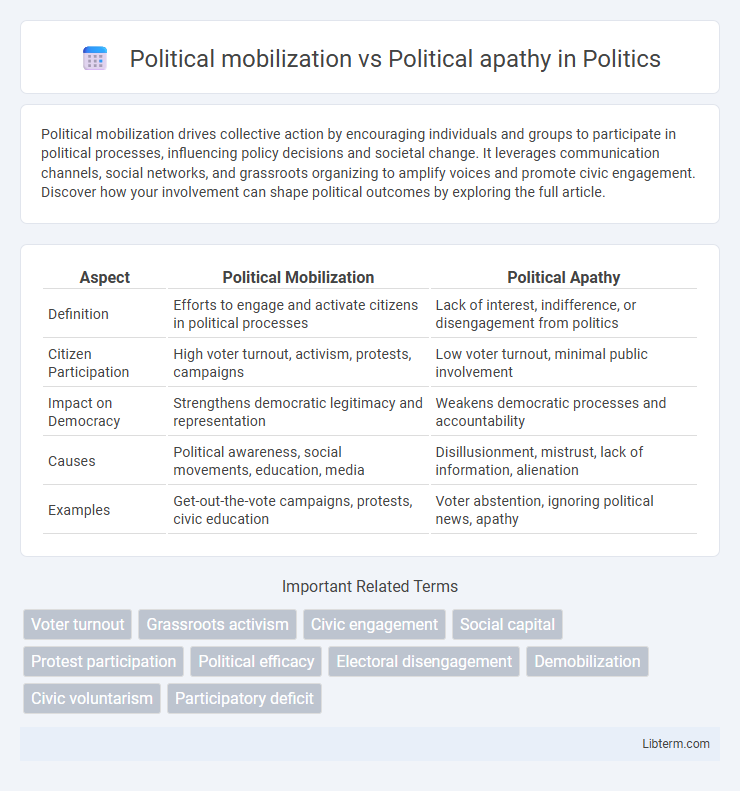Political mobilization drives collective action by encouraging individuals and groups to participate in political processes, influencing policy decisions and societal change. It leverages communication channels, social networks, and grassroots organizing to amplify voices and promote civic engagement. Discover how your involvement can shape political outcomes by exploring the full article.
Table of Comparison
| Aspect | Political Mobilization | Political Apathy |
|---|---|---|
| Definition | Efforts to engage and activate citizens in political processes | Lack of interest, indifference, or disengagement from politics |
| Citizen Participation | High voter turnout, activism, protests, campaigns | Low voter turnout, minimal public involvement |
| Impact on Democracy | Strengthens democratic legitimacy and representation | Weakens democratic processes and accountability |
| Causes | Political awareness, social movements, education, media | Disillusionment, mistrust, lack of information, alienation |
| Examples | Get-out-the-vote campaigns, protests, civic education | Voter abstention, ignoring political news, apathy |
Introduction: Defining Political Mobilization and Political Apathy
Political mobilization refers to the process by which individuals or groups are actively encouraged and organized to participate in political activities such as voting, protests, or campaigns. Political apathy describes a lack of interest, enthusiasm, or concern for political participation, often resulting in low voter turnout and civic engagement. Understanding these contrasting phenomena is essential for analyzing democratic participation and the effectiveness of political systems.
Historical Evolution of Political Engagement
Political mobilization historically surged during periods of social upheaval, such as the civil rights movement in the 1960s and the labor movements of the early 20th century, reflecting increased civic participation and organized advocacy. In contrast, political apathy often rose during times of economic stability or disillusionment, exemplified by declining voter turnout in the post-World War II era and amid contemporary digital distractions. The evolution of political engagement highlights shifting societal priorities, technological advancements, and changing trust levels in governmental institutions.
Causes and Factors Influencing Political Mobilization
Political mobilization is driven by factors such as strong group identity, perceived political efficacy, social networks, and media influence, which motivate individuals to participate in political processes. Economic disparities, social injustices, or crises often catalyze mobilization by increasing political awareness and urgency. Conversely, political apathy stems from feelings of alienation, distrust in government institutions, lack of interest, or perceived inefficacy, which dissuade citizens from engaging in political activities.
Roots and Drivers of Political Apathy
Political apathy stems from a combination of factors including disillusionment with political institutions, lack of trust in government, and perceived inefficacy of voting or activism, often exacerbated by socioeconomic disparities and limited political education. Media influence and negative campaigning intensify feelings of cynicism, reducing motivation to participate in electoral processes and civic engagement. Root causes also encompass barriers such as voter suppression, complex electoral systems, and a disconnect between political elites and marginalized communities, all of which undermine political mobilization efforts.
Societal Impacts of Active Political Participation
Active political participation strengthens democratic institutions by fostering accountability, transparency, and citizen empowerment in governance processes. High levels of political mobilization lead to increased public policy responsiveness and social cohesion, reducing inequality and promoting inclusive development. In contrast, political apathy results in weakened representation and diminished community engagement, which can exacerbate social fragmentation and undermine the legitimacy of political systems.
Consequences of Widespread Political Apathy
Widespread political apathy leads to lower voter turnout, weakening democratic legitimacy and reducing governmental accountability. This disengagement fosters the rise of unrepresentative leadership and increases the risk of authoritarianism due to diminished public oversight. Persistent apathy can erode civic trust, undermine policy responsiveness, and exacerbate social inequalities through marginalized political participation.
Role of Media in Shaping Political Engagement
Media platforms significantly influence political mobilization by disseminating information, framing political issues, and facilitating public discourse, which enhances voter turnout and activism. Conversely, media exposure to negative or biased content can contribute to political apathy by fostering disengagement and cynicism among the audience. The rise of social media algorithms also selectively filters political content, impacting users' awareness and motivation to participate in the political process.
Strategies to Combat Political Apathy
Effective strategies to combat political apathy include enhancing civic education to increase awareness of political processes and the importance of participation. Implementing community engagement programs and leveraging social media platforms can stimulate interest and involvement, particularly among younger demographics. Encouraging transparent governance and addressing public concerns promptly also rebuild trust in political institutions, fostering higher voter turnout and activism.
Case Studies: Comparing Mobilized vs Apathetic Societies
Case studies comparing political mobilization and apathy reveal stark differences in voter turnout, civic engagement, and policy responsiveness. For instance, countries like Sweden, with high political mobilization, showcase robust democratic participation and social trust, whereas societies such as Italy often display political apathy marked by low voter turnout and disengagement. These contrasts emphasize the critical role of education, media freedom, and institutional transparency in driving active political participation versus widespread political indifference.
Conclusion: Bridging the Gap Between Mobilization and Apathy
Bridging the gap between political mobilization and apathy requires targeted strategies that address the root causes of disengagement, such as lack of trust and perceived inefficacy. Empowering underrepresented groups through education, transparent communication, and inclusive policymaking enhances voter turnout and civic participation. Strengthening community outreach and leveraging digital platforms can transform apathy into active involvement, fostering a more vibrant and representative democracy.
Political mobilization Infographic

 libterm.com
libterm.com